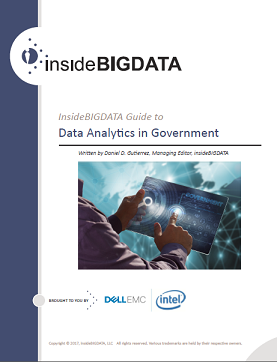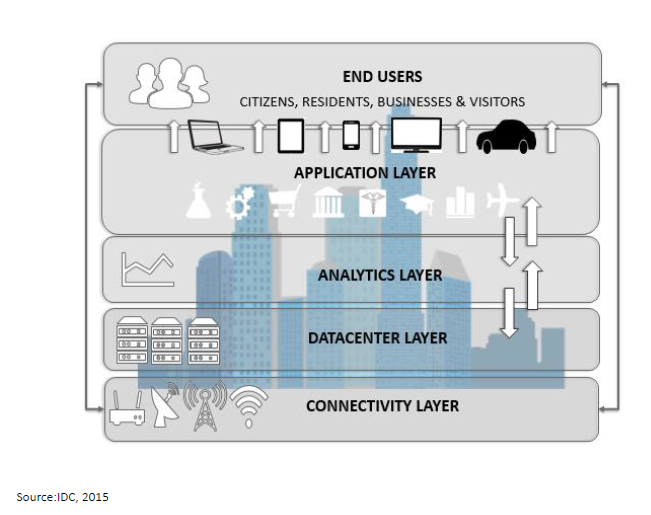The insideBIGDATA Guide to Data Analytics in Government provides an in-depth overview of the use of data analytics technology in the public sector. Focus is given to how data analytics is being used in the government setting with a number of high-profile use case examples, how the Internet-of-Things is taking a firm hold in helping government agencies collect and find insights in a broadening number of data sources, how government sponsored healthcare and life sciences are expanding, as well as how cybersecurity and data analytics are helping to secure government applications.
 Government Applications of IoT
Government Applications of IoT
The Internet of Things (IoT) is a term used to describe the set of physical objects embedded with sensors and connected to the Internet. IoT offers numerous opportunities for the Federal Government to cut costs and improve citizen services. The data visualization “Growth in the Internet of Things” (below) shows the tremendous growth in the number of connected devices across all sectors.
Smart Cities
IDC defines a Smart City (also known as digital city) as being a “finite entity (district, town, city, county, municipal, and/or metropolitan area) with its own governing authority that is more local than national. This entity is built on an information and communication technology (ICT) foundation layer that allows for efficient city management, economic development, sustainability, innovation, and citizen engagement.”
Data is one of the most critical elements that will underpin the success of a city’s transformation into a smart city. To be deemed successful, a city should be able to harness data from existing government systems, online and mobile applications, third-party applications, and, most importantly, from citizens —the ultimate beneficiaries of smart cities. The data that is gathered can be analyzed and used to make informed, automated decisions that can improve the life of citizens and better manage local resources.

Smart cities are communities that harness technology to transform physical systems and services in a way that enhances the life of its residents and business while making government more efficient. It is more than a mere automation of processes; it also links disparate systems and networks to gather and analyze data that is then used to transform whole systems. While the idea behind smart cities has been around for years, it has acquired a new urgency as more people move into urban centers. Sustainability is becoming an important imperative and technologies have advanced to a point where there can be realtime and meaningful interaction between cities, residents, and businesses.
According to the U.S. Smart Cities Council, another perspective of a smart city is a “system of systems —water, power, transportation, emergency response, and others—with each one affecting all the others.” In recent years, the ability to merge multiple data streams and analyze them for critical insights has been refined. Those insights are what enhance livability, workability, and sustainability in a city. The overarching goal is to make cities more efficient, and ensure resources are found where they’re needed.
A new report by The Wharton School, Smart Cities: The Economic and Social Value of Building Intelligent Urban Spaces, suggests that the worldwide trend toward building smart cities is getting the creative juices of urban planners, entrepreneurs, and citizens flowing. Some projects are impressive in their innovation, while others are laudable for their scale and impact. Typically, these projects begin in discrete pockets of existing cities, where they can generate a “proof of concept,” improve upon their design while gaining insights, and go on to replicate them in other parts of the city or in other communities. A less common example is the building of brand new cities, such as Songdo in South Korea or one planned in China’s Guangdong province. Innovative work from around the world in smart cities touches on a wide range of areas including energy, healthcare, transportation, parking, crime management, adaptive reuse of existing and unused infrastructure, citizen participation, and enhanced overall quality of life.
Other examples of smart cities include Barcelona, where the drive to revolutionize began more than a dozen years ago, Copenhagen with a focus on boosting sustainability, Charlotte, North Carolina, with a successful energy efficiency program, and China’s capital city, Beijing. There also is a strong push in the Middle East toward smart cities and adopting IoT and the technologies that benefit from machine learning, originating from the perspective of public safety and security. The U.S., which came later to the game, is now getting its act together at the Federal Government level, although several U.S. cities, including New York, Philadelphia, and San Francisco, launched such initiatives years before the term “smart city” or “digital city” became a buzzword. Smart cities are driven by the amount of data and ability to cross many verticals in the government space.
In September 2015, the Obama administration announced a smart cities initiative to invest more than $160 million in at least two dozen research and technology collaborations to help communities across the country tackle challenges ranging from fighting crime and reducing traffic congestion to fostering economic growth. Digital cities, based on IoT technologies, use traffic lights to analyze traffic patterns.
According to a report by Frost & Sullivan, Strategic Opportunity Analysis of the Global Smart City Market, smart cities will represent a market value of USD 1.565 Trillion by 2020, driven by investments in sectors such as smart districts, utilities, healthcare, security, and governance.
One caveat is that it’s harder for the public sector in developed Western economies to cultivate a smart city, with civil liberties concerns centered on if and how data is leaving the city. Security and privacy concerns work to restrict data leaving the city, and more broadly, leaving the host country.
Smart cities also involve putting resources in the right place. As an example, you have limited resources with police, limited staffing for EMTs, limited numbers of fire stations, trucks, ambulances, etc. The goal is to develop predictive models—for instance Austin, TX has intersections that have the most traffic between the hours of 4-6pm, and predicting the most likely intersections to have an accident is a tremendous benefit for public safety. When you look at those areas with traffic issues, patterns emerge and you can allocate resources to those identified parts of the city. If you can predict that you’re going to have five or six accidents in downtown Austin, you can schedule resources around the downtown area in case that happens. As a specific example, a major event like the Austin City Limits (ACL) music festival attracts upwards of 70,000 people in the central part of the city—where do you put emergency services, where do you put police, where do you put traffic cops, where do you put EMTs? Smart cities means allocating resources at the right time.

Motivations and Challenges for Government Use of IoT
Where federal agencies have begun deploying IoT solutions, it is typical to pursue several primary goals: increase efficiency, reduce costs, and offer new services (e.g. anti-crime surveillance). Major projects include a smart buildings initiative to reduce energy costs, a telematics program to increase the efficiency of government vehicles, an effort to improve asset management, and an automated process to replace manual data-collection.
Several federal agencies have used the IoT as an opportunity to create services in support of their missions. Major new projects that use the IoT include improving national defense, monitoring the natural world, and enhancing safety and public health.
Adoption of IoT technology for government applications, however, doesn’t always follow a straight line. The Federal Government faces a number of challenges that have hampered the adoption of the IoT in the public sector. First, there is a lack of strategic leadership at the federal level about how to make use of the IoT. Second, federal agencies do not always have workers with the necessary technical skills to effectively use data generated by the IoT. Third, federal agencies do not have sufficient funding to modernize their IT infrastructure and begin implementing IoT pilot projects. Fourth, even when funding exists, federal procurement policies often make it difficult for agencies to quickly and easily adopt the technology. Finally, risks and uncertainty about privacy, security, interoperability, and return on investment delay federal adoption as potential federal users wait for the technology to mature and others to adopt first.
If you prefer, the complete insideBIGDATA Guide to Data Analytics in Government is available for download in PDF from the insideBIGDATA White Paper Library, courtesy of Dell EMC.





Speak Your Mind